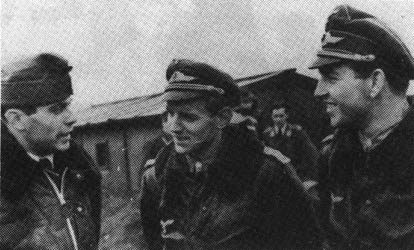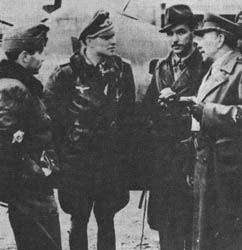|
Százados László Pottyondy

László Pottyondy together with the two greatest fighter pilots of all time,
Erich Hartmann and Gerhard Barkhorn.
Pottyondy took part in the Slovakian-Hungarian border
conflict in March 1939.
On 24 March 1939 Hungarian Ju86K-2 bombers attacked Spisska Nova Ves’ airport.
The bombers were escorted by CR.32s from the 1/2. vadászszázad.
For his part in this escort mission Pottyondy was decorated with the bronze
Signum Laudis.
He served in the 2/3. “Richie” vadászszázad (Fighter Squadron) operating Fiat
CR.42s in the summer and autumn of 1941 during the units operations against the
Soviet Union.
On 12 July alezredes (Lieutenant Colonel) Orosz, commander of the air contingent
attached to the Fast corps, ordered százados (Captain) Aladár Szobránczy,
commander of 2/3. vadászszázad, to provide escort for two short-range
reconnaissance squadrons, which were to bomb an enemy transport assembly point
west of Zwanczyk. Szobránczy, föhadnagy (Lieutenant) Pottyondy, hadnagy (Second
Lieutenant) Gyözö Vámos (CR.42 V-265), szakaszvezetö (Lance-Sergeant) Péter Soós
and szakaszvezetö János Balogh took off at 10:00 hours and soon joined the
formation of WM 21 Sólyom aircraft. On the way to the target Szobránczy caught
sight of three twin-engined Soviet bombers. As the Fiats dived on them seven
Soviet I-16s appeared suddenly and engaged the Hungarian biplanes. Szobránczy
selected a Soviet fighter and soon saw his tracers penetrating the cockpit. The
machine began to trail thick smoke and hit the ground. Pottyondy also attacked
an I-16 but, at the same time, he was jumped by another I-16. He noticed with
satisfaction that Soós took over his victim-to-be and he was able to concentrate
on his attacker. Despite the Soviet machine’s advantage of altitude, thanks to
the superb manoeuvrability of the CR.42, Pottyondy managed to get behind the
Russian and his bullets tore pieces of the fuselage. The Russian pilot steadied
his plane only to fly into the machine gun fire of the oncoming Vámos. The two
machines raced towards each other and in the next second they collided head-on.
Pottyondy saw two parachutes floating downward but he was immediately attacked
by another I-16. It took some time to get behind this opponent but he finally
did it. The bullets hit the tail and then moved forward on to the section
between the engine and the cockpit. Pottyondy knew that he finally had got his
first victory out of three chances since smoke poured out from the I-16s engine
as the Fiat’s machine guns kept pounding the fuselage. Finally it spun towards
the earth out of control. Meanwhile the WM 21 Sólyoms had completed their task
and turned for home.

Pottyondy and Balogh, who also had shot down an I-16, were the last to leave the
area yet they were the first back in Kolomea. Soon Soós arrived and also
reported an air victory. On the return he had got low on fuel and had to land to
refuel at another airfield. However Vámos, who they know had bailed out after
the collision, and Szobránczy were still missing. After shooting down his
opponent and watching Vámos collision, Szobránczy had decided to try to find
him. Circling around the parachute, he noticed that Vámos hung motionless. When
his body hit the top of threes a Russian patrol appeared at the edge of the
wood. Szobránczy sent the Russians running with a few well-aimed bursts. Looking
around he saw a meadow along the south-east edge of the forest and put the Fiat
down. The machine came to a halt after about 250 feet and the undercarriage sank
into the soft ground. A group of horsemen appeared galloping towards him and
Szobránczy draw his pistol but, to his great relief, it was not needed for they
were Hungarian hussars who had watched his landing. Szobránczy detailed a hussar
to guard the plane, mounted the hussars horse and began to search for Vámos.
They found the parachute quickly, but it took ninety minutes to find the pilot,
who they found sleeping in an abandoned forester hut! The happy Vámos explained
that he lost consciousness upon the impact and did not remember pulling the
ripcord. He came to when he hit the foliage. At the edge of the forest he was
fired on, so he went farther into the woods until he saw the hut where,
exhausted, he fell into a deep sleep. In the meantime a Hungarian armoured unit
reached the scene and then towed the Fiat on to solid ground. Szobránczy landed
back at Kolomea at 19:00 and the unit could claim five victories during the day
with no losses of pilots.
According to some sources was the I-16, which collided with Vámos credited as an
unconfirmed to Pottyondy, who fired at this aircraft before the collision.
After the combat on 12 July Aladár Szobránczy and Gyözö Vámos were decorated
with the bronze Signum Laudis while Pottyondy received the silver Signum Laudis.
A few days later the “Richie” vadászszázad was pulled back to Hungary.
Pottyondy served on the Eastern front again in 1942. This time with the 2/1.
vadászszázad, which was equipped with Re.2000 fighters.
Later in the war Pottyondy became an ace.
On 6 June 1944 the 102/2. vadászszázad arrived at the Soviet front. They had
previously been based at Kolozsvár conducting fighter training and anti-aircraft
defence roles on Re.2000 Héjas and immediately commenced its conversion onto the
Bf109.
On 9 June 1944 föhadnagy Pottyondy took command over the 102/2. vadászszázad.
The 102/2. vadászszázad went into action in the beginning of July.
On 22 July they pulled back to Reichshof but two days later they moved to Mielec
and then to Balitze on 27 July.
On 15 September Pottyondy claimed a Il-2 near Mezdilaborze.
In October the unit moved together with the 102/1. vadászszázad from Munkács to
Felsöábrány. On 21 October both units were pulled back to Ferihegy.
Whilst based at Ferihegy Pottyondy was promoted to százados.
The 102/2. vadászszázad was soon moved to Bábolnapuszta, near Györ.
On 1 November Hungarian fighters intercepted Boston bombers and their escort
fighters, which were attacking German-Hungarian troops near Cegléd. Zászlós
István Kálmán of the 102/1. vadászszázad and föhadnagy Ferenc Málnássy of the
102/2. vadászszázad each claimed a Boston while Pottyondy claimed a La-5.
On 17 November 1944 the 102. osztály (Fighter Group) operated together with JG52
against Soviet bombers and ground-attack planes at the foot-hills of the Mátra
Mountains. During the day Pottyondy flew a mission with Hauptmann Erich Hartmann
as wingman. On the sortie, each of them shot down one of the Bostons, which were
attacking targets at Budapest. Pottyondy’s victim crashed near Ocsa, while
Hartmann’s went down near Erzsébetfalva.
Pottyondy left 102/2. vadászszázad on 31 December after having claimed 7
victories while flying Bf109Gs.
From 7 July to 31 December the 102/2. vadászszázad flew 334 missions and spent
309 hours over enemy territory. It downed 18 aircraft and destroyed a tank. The
unit lost three pilots and seven aircraft in action and 18 to mechanical
failure.
From 1 January 1945 he moved to the Home front and commanded the 101/8.
vadászszázad, which core consisted of pilots from his old unit 102/2.
vadászszázad.
Between 10:07 and 11:05 on 20 February 1945 eight aircraft from the 101/8.
vadászszázad were on a fighter sortie. They noted Soviet close-support aircraft
and fighters flying at 500 metres near Szendehely. The camouflaged Il-2s flew
close to the ground and tried to blend in, while the Yaks took up the challenge.
Not far from the village, Pottyondy “sat” behind one of the Yaks and shot it
down with rounds from his 30-mm cannon. The left wing of the Yak almost tore off
in the air. The fighter exploded on impact with the ground.
At 15:50 on 8 March 1945 he led a flight of four aircraft to relieve another
flight. They ran into Il-2s, escorted by Yak-9s, between Soponya and Kálóz. They
attacked the Il-2s, which were in the process of a low-level attack, and
Pottyondy claimed one of them. One Bf109G “White 4” flown by föhadnagy Victor
Inkey was shot down by Soviet anti-aircraft fire and he bailed out over enemy
held territory.
He claimed 5 victories flying Bf109Gs with the 101/8. vadászszázad. He continued
to serve with this unit until 4 May 1945.
Pottyondy ended the war with 1 biplane victory and a total of 13.

László Pottyondy and Gerhard Barkhorn speaking to two war correspondents.
After the war he emigrated to Little Rock, USA, with his wife Eva.
Here he befriended the owner (also a Hungarian dissent) of the local airport,
who helped him to get his flying certificate.
After receiving his flying license he flew crop dusting and was killed while
doing so in 1952.
Claims:
|
Kill no. |
Date |
Number |
Type |
Result |
Plane type |
Serial no. |
Locality |
Unit |
|
|
1941 |
|
|
|
|
|
|
|
|
1 |
12/07/41 |
1 |
I-16 |
Destroyed |
Fiat CR.42 |
|
W Zwanczyk |
2/3. vadászszázad |
|
|
12/07/41 |
1 |
I-16 (a) |
Unconfirmed |
Fiat CR.42 |
|
W Zwanczyk |
2/3. vadászszázad |
|
|
1944 |
|
|
|
|
|
|
|
|
2 |
15/09/44 |
1 |
Il-2 |
Destroyed |
Bf109G |
|
near
Mezdilabortze |
102/2.
vadászszázad |
|
3 |
09/10/44 |
1 |
La-5 |
Destroyed |
Bf109G |
|
Tuchla |
102/2.
vadászszázad |
|
4 |
30/10/44 |
1 |
Boston |
Destroyed |
Bf109G |
|
Kiskörös |
102/2.
vadászszázad |
|
5 |
30/10/44 |
1 |
Yak-9 |
Destroyed |
Bf109G |
|
Törökszentmiklós |
102/2.
vadászszázad |
|
6 |
01/11/44 |
1 |
La-5 |
Destroyed |
Bf109G |
|
Cegléd area |
102/2.
vadászszázad |
|
7 |
17/11/44 |
1 |
Boston |
Destroyed |
Bf109G |
|
near Ócsa |
102/2.
vadászszázad |
|
8 |
22/12/44 |
1 |
Il-2 |
Destroyed |
Bf109G |
|
Csány |
102/2.
vadászszázad |
|
|
1945 |
|
|
|
|
|
|
|
|
9 |
03/01/45 |
1 |
Yak-9 |
Destroyed |
Bf109G |
|
Csapdi |
101/8.
vadászszázad |
|
10 |
14/01/45 |
1 |
Boston |
Destroyed |
Bf109G |
|
Pilisvörösvár
area |
101/8.
vadászszázad |
|
11 |
22/01/45 |
1 |
La-5 |
Destroyed |
Bf109G |
|
Ercsi area |
101/8.
vadászszázad |
|
12 |
20/02/45 |
1 |
Yak-9 |
Destroyed |
Bf109G |
|
near Szendehely |
101/8.
vadászszázad |
|
13 |
08/03/45 |
1 |
Il-2 |
Destroyed |
Bf109G |
|
Soponya-Kálóz |
101/8.
vadászszázad |
|
